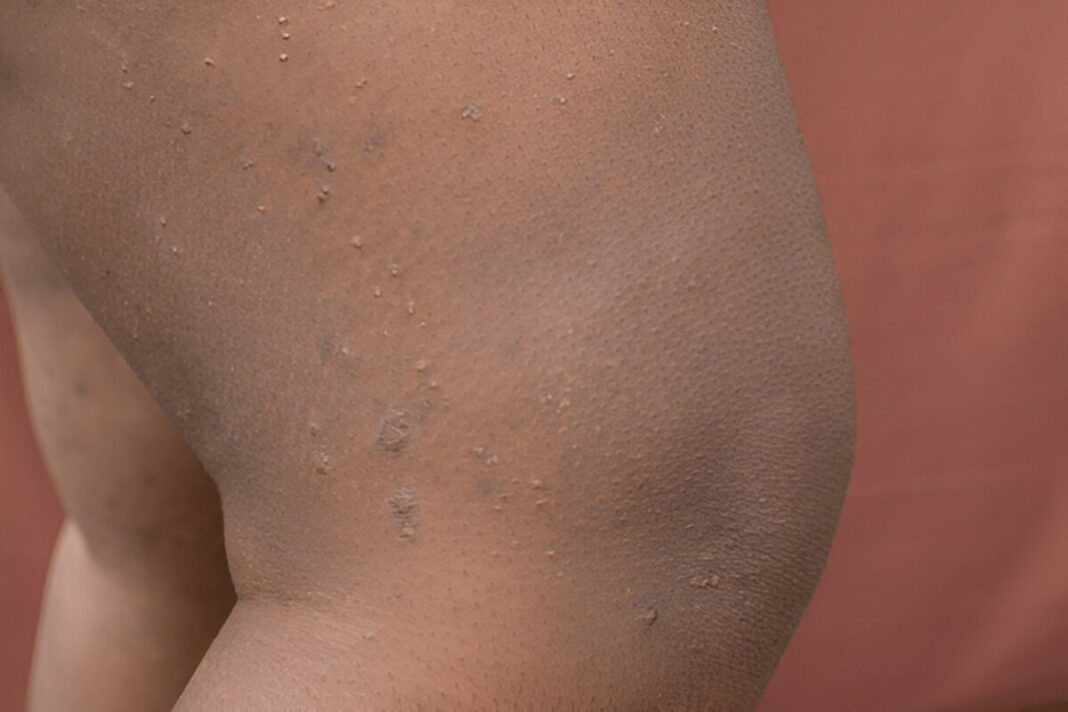Eczema, or atopic dermatitis, is a chronic inflammatory skin condition that affects people of all races and ethnicities. However, its presentation and management can vary significantly based on skin tone. These differences are too often overlooked in dermatological practice. For Black and Brown individuals, eczema can present uniquely, leading to underdiagnosis, misdiagnosis, or inadequate treatment. Understanding these nuances is essential to providing equitable care and improving patient outcomes.
How Eczema Presents Differently in Melanated Skin
In lighter skin tones, eczema typically appears as red, scaly, and inflamed patches. But in darker skin, inflammation may look purple, gray, brown, or ashen rather than red. These subtler signs can be easily missed or mistaken for other conditions like post-inflammatory hyperpigmentation or fungal infections (Silverberg & Hanifin, 2013).
Additionally, people with darker skin tones are more likely to develop follicular eczema, where the condition presents as small, itchy bumps, often on the torso or arms. These may resemble acne or keratosis pilaris, further complicating accurate diagnosis. Because many medical textbooks and diagnostic references lack diverse skin imagery, even trained dermatologists may misinterpret these symptoms in Black and Brown patients (Taylor et al., 2020).
The Role of Medical Education and Implicit Bias
Medical education has historically emphasized dermatological conditions as they appear on white skin. This creates a significant knowledge gap. A 2018 study found that fewer than 5% of dermatologic images in U.S. medical textbooks depicted darker skin (Louie & Wilkes, 2018). This underrepresentation contributes to a cycle in which providers are less equipped to recognize common skin diseases in patients of color.
Moreover, implicit bias in clinical practice may affect how seriously a patient’s symptoms are taken. For instance, itching a hallmark of eczema may be underestimated in Black patients, who are sometimes incorrectly perceived to tolerate pain or discomfort differently than white patients (Hall et al., 2015).
Treatment Challenges and Skin-Specific Considerations
Even when diagnosed correctly, treatment strategies often fail to consider the unique needs of melanated skin. Topical corticosteroids, the mainstay of eczema treatment, can cause hypopigmentation. This is a particular concern for patients with darker skin, where such changes are more noticeable and distressing. Overuse may lead to skin thinning and increased susceptibility to other pigment disorders.
Another common challenge is the post-inflammatory hyperpigmentation that often follows eczema flare-ups in darker skin. While the inflammation may subside, the resulting dark spots can linger for months, affecting patients’ self-esteem and quality of life (Callender et al., 2011). Therefore, managing eczema in Black and Brown skin isn’t just about controlling inflammation. It’s also about preventing and treating discoloration.
The Importance of Moisture and Barrier Repair
People with darker skin types may have lower ceramide levels, which are lipids essential to maintaining the skin’s barrier function. This makes the skin more prone to dryness and transepidermal water loss, both of which can exacerbate eczema symptoms (Rawlings, 2006). Moisturizers rich in ceramides, urea, or hyaluronic acid are especially beneficial for restoring skin integrity in these cases.
Cultural practices also play a role. For example, the use of heavy oils and butters like shea butter or coconut oil is common in Black communities. While some of these natural remedies offer emollient benefits, they may not always provide sufficient barrier repair or anti-inflammatory properties unless combined with medical treatments.
Advocating for Inclusive Dermatology
To improve outcomes for patients of color, there needs to be a concerted effort to diversify dermatology research, training, and resources. Medical curricula must include more imagery and case studies involving darker skin tones. Practitioners should pursue continuing education that addresses skin-of-color dermatology and recognize the importance of culturally competent care.
Patients can also advocate for themselves by seeking dermatologists with experience in treating skin of color. The Skin of Color Society (skinofcolorsociety.org) provides directories and educational materials to bridge these gaps in care.
A Call for Equity in Skin Health
Eczema is a universal condition, but its impact is not felt equally. For Black and Brown individuals, the journey to diagnosis and effective treatment is often longer and more complicated. Addressing this disparity requires a shift in both awareness and action, from the exam room to the pages of medical textbooks.
By acknowledging the overlooked differences in how eczema affects melanated skin, we take an essential step toward health equity and personalized care for all skin tones.
References
- Callender, V. D., Alexis, A. F., Daniels, S. R., & Kaw, C. R. (2011). Racial differences in the clinical characteristics of atopic dermatitis. The Journal of Clinical and Aesthetic Dermatology, 4(10), 20–24.
- Hall, W. J., Chapman, M. V., Lee, K. M., et al. (2015). Implicit racial/ethnic bias among health care professionals and its influence on health care outcomes: a systematic review. American Journal of Public Health, 105(12), e60–e76. https://doi.org/10.2105/AJPH.2015.302903
- Louie, P., & Wilkes, R. (2018). Representations of race and skin tone in medical textbook imagery. Social Science & Medicine, 202, 38–42. https://doi.org/10.1016/j.socscimed.2018.02.023
- Rawlings, A. V. (2006). Ethnic skin types: Are there differences in skin structure and function? International Journal of Cosmetic Science, 28(2), 79–93. https://doi.org/10.1111/j.1467-2494.2006.00302.x
- Silverberg, J. I., & Hanifin, J. M. (2013). Adult eczema prevalence and associations with asthma and other health and demographic factors: a US population-based study. Journal of Allergy and Clinical Immunology, 132(5), 1132–1138. https://doi.org/10.1016/j.jaci.2013.08.031
- Taylor, S. C., Cook-Bolden, F., Rahman, Z., & Strachan, D. (2020). Acne and hyperpigmentation in skin of color: Challenges and solutions. Dermatologic Clinics, 38(2), 233–242. https://doi.org/10.1016/j.det.2019.11.007











